Sold Ceramics
Sold Chinese Imari 1700-1800
Tea, Coffee and Chocolate wares
Page 2
Chinese porcelain producers developed new types of decorations in the early 18th century, Chinese Imari being one of them. It is characterised by a combination of underglaze blue and overglaze red and gold. Details are sometimes in black and green enamels. This development was a reaction to the success of Japanese Imari porcelain with a similar colour scheme. Sometimes Chinese imitations are direct copies of Japanese examples but more often Chinese Imari is decorated with typical Chinese motifs that are closely related to the underglaze-blue patterns of the period. However, the use of red and gold makes Chinese Imari more lavish. Landscapes, flowering plants, birds and mythical creatures are recurring motifs. Depictions of humans are less frequent and apart from armorial pieces, European designs are quite rare. The shapes fit into the normal export assortment. Chinese Imari was not only in demand in the West, but also in south-east Asia, India, and the Ottoman Empire. In the VOC (Dutch East India Company, 1602–1799) records it is called 'Chinese-Japanese' and in addition to blue and white and enamelled wares, this was a standard type in the Company's assortment that was bought in Canton until the end of the 18th century.
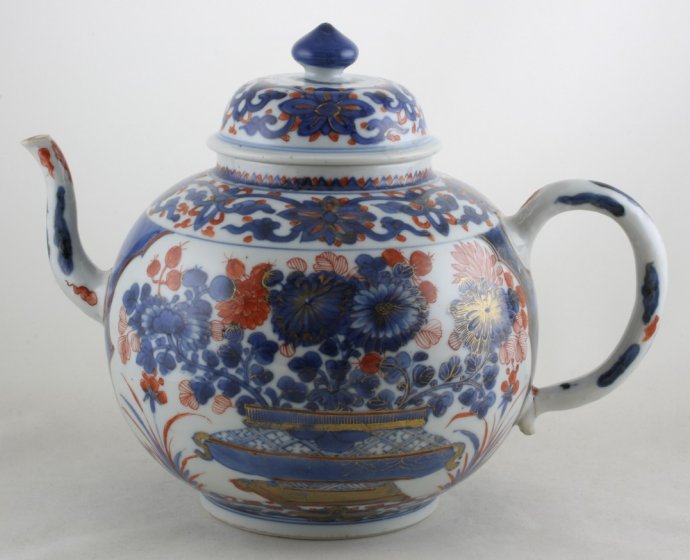
Sold Ceramics - Sold Chinese Imari 1700-1800 - Tea, Coffee and Chocolate wares - Page 2
Object 2012529
Large teapot or hot water pot
China
1720-1730
Height with cover 213 mm (8.39 inch), height without cover 157 mm (6.18 inch), diameter handle to spout 272 mm (10.71 inch), diameter of mouthrim 80 mm (3.15 inch), diameter of footring 92 mm (3.62 inch), weight including cover 1,475 grams (52.03 ounce (oz.)), weight cover 183 grams (6.46 ounce (oz.))
Large teapot or hot water pot on footring, curved handle and an S-shaped spout. Domed lid with pointed knob. Chinese Imari, decorated in underglaze blue, overglaze iron-red and gold, with
Very strong and concentrated tea was often drawn in the normal sized teapots. It was used to pour a thin layer into a teacup which was then diluted with hot water from a bouilloire to make it drinkable. Often a little milk was added to soften the taste. This large hot water pot probably served as a boulloire and will have been part of a large tea set. (Jörg 2011/2, p.132, cat. 120)
Jörg suggest that these large size pots might also have been used for wine or punch. (Jörg 2011/2, p.132, cat. 120)
In the collection of Oriental Ceramics of the Groninger Museum is a Japanese tea set that consists of an teapot / hot water pot, six cups and saucers for tea or coffee, six chocolate cups with covers and saucers, a bowl with an overturned rim that might have been a sugar bowl and a ewer which may have been used as a milk jug but could also have been a condiment jug in a dinner set of which parts are also in the Groninger Museum. The set entered the Groninger Museum in 1899 as a bequest of the local collector, Mr. Mello Backer. (Jörg 2003/1, p.201)
For another tea or water pot, please see:
- Famille Verte, Chinese Porcelain in Green Enamels, (C.J.A. Jörg, Schoten, 2011), p.132, cat. 120.
-
Sold Ceramics - Sold Japanese Imari 1690-1800 - 'Gold' Imari - Page 1 - Object 2010668.
For a large teapot / hot water pot in the collection of Oriental ceramics of the Groninger Museum, please see:
Condition: Firing flaws to the body, the handle attachment and the inner footring. The attachment of the underside of the handle to the body with a circular firing tension hairline and a glaze rough spot. A short hairline to the rim of the cover.
References:
Price: Sold.

Sold Ceramics - Sold Chinese Imari 1700-1800 - Tea, Coffee and Chocolate wares - Page 2
Object 2012528
Teapot
China
1700-1720
Height with cover 100 mm (3.94 inch), height without cover 75 mm (2.95 inch), diameter handle to spout 125 mm (4.92 inch), dimension of mouthrim 44 mm (1.73 inch), diameter of footring 48 mm (1.89 inch), weight with cover 229 grams (8.08 ounce (oz.)), weight cover 31 grams (1.09 ounce (oz.))
Pear-shaped, ribbed teapot with fluted body on footring. Straight spout, curved C-shaped handle. Domed ribbed cover with a round knob. Chinese Imari, decorated in underglaze blue, overglaze iron-red and gold with various butterflies and insects in flight. On the spout and handle flower sprays. Around the rim a narrow border of lotus leaves in underglaze blue with iron-red and gold accents. On and around the rim of the cover a narrow border of lotus leaves in underglaze blue with iron-red and gold accents.
Condition: A shallow rough tip of the spout and two chips to the inner footring.
Price: Sold.
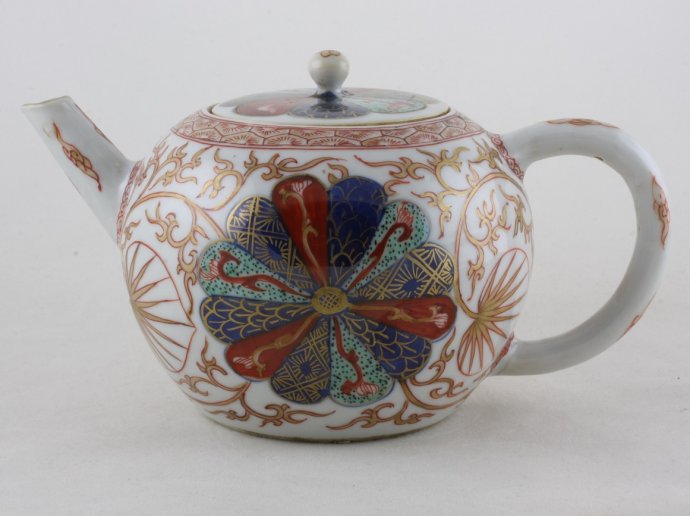
Sold Ceramics - Sold Chinese Imari 1700-1800 - Tea, Coffee and Chocolate wares - Page 2
Object 2012367
Teapot
China
1700-1720
Height including the cover 99 mm (3.90 inch), diameter handle to spout 175 mm (6.89 inch), diameter of mouthrim 64 mm (2.52 inch), diameter of footring 62 mm (2.44 inch), weight with cover 411 grams (14.50 ounce (oz.)), weight cover 36 grams (1.27 ounce (oz.))
Teapot of globular shape on a footring. Straight spout with a curved C-shaped handle. The inlaying flat cover (pierced) with round knob. Chinese Imari, decorated in underglaze blue, and overglaze iron-red, green and black enamel and gold with on either side a stylized 12-petal chrysanthemum crest, (kiku no mon). The petals are decorated in gold and iron-red, gold reserved on an underglaze blue ground and iron-red on a densely painted green-speckled ('frog's-spawn') ground. Those in gold reserved on an underglaze blue ground show either a lozenge / diaper pattern (tasuki) or scale pattern. Those in red and gold show designs of a stylised fungus. Those in iron-red on a densely painted green-speckled ('frog's-spawn') ground also show a stylised fungus. The stylized 12-petal chrysanthemum crest is flanked by two large leaves and leafy scrolls. Round the mouth a border with two rows with stylised half flowerheads. On the spout and handle scattered stylised clouds. Round the attachments of the handle and the spout stylised cloud pattern borders. The cover is decorated en suite.
Chinese porcelain producers developed new types of decorations in the early 18th century, Chinese Imari being one of them. It is characterized by a combination of underglaze blue and overglaze red and gold. Details are sometimes in black and green enamels. This development was a reaction to the success of Japanese Imari porcelain with a similar colour scheme. Sometimes Chinese imitations, (see the decoration on this particlar teapot) are direct copies of Japanese examples but more often Chinese Imari is decorated with typical Chinese motifs that are closely related to the underglaze-blue patterns of the period. However, the use of red and gold makes Chinese Imari more lavish. Landscapes, flowering plants, birds and mythical creatures are recurring motifs. Depictions of humans are less frequent and apart from armorial pieces, European designs are quite rare. The shapes fit into the normal export assortment. Chinese Imari was not only in demand in the West, but also in south-east Asia, India, and the Ottoman Empire. In the VOC (Dutch East India Company, 1602–1799) records it is called 'Chinese-Japanese' and in addition to blue and white and enamelled wares, this was a standard type in the Company's assortment that was bought in Canton until the end of the 18th century.
Chinese Imari usually confined itself to iron-red, underglaze blue, and gold, but occasionally it was enriched with famille verte panels. It was based on the Japanese wares of a similar type made in the Arita kilns and exported to Europe in enormous quantities from the port of Imari in the Southern Island. (Boulay 1984, p.252)
The production of Chinese Imari starting in the early years of the 18th century, reached its peak in the 1720s and 1730s, but became formalised and repetitive in the next decades. Although Chinese Imari was primarily produced for export, it may be noted that there are some pieces in this style in the Palace Museum, Beijing. If these really were part of the imperial collection and not later additions, they are an indication that Chinese Imari was also appreciated by the Chinese an probably served as some kind of "Western" exotic ware. (Jörg & Van Campen 1997, pp.199-200)
An identically shaped, sized and decorated teapot is in the collection of Augustus the Strong in Dresden and registered under the number P.O. (Porzellan Ostasien) 478 For this teapot, please see;
Condition: A firing tension hairline to the underside of the attachment of the handle.
References:
Jörg & Van Campen 1997, pp.199-200
SKD Online collection, PO. 478
Price: Sold.
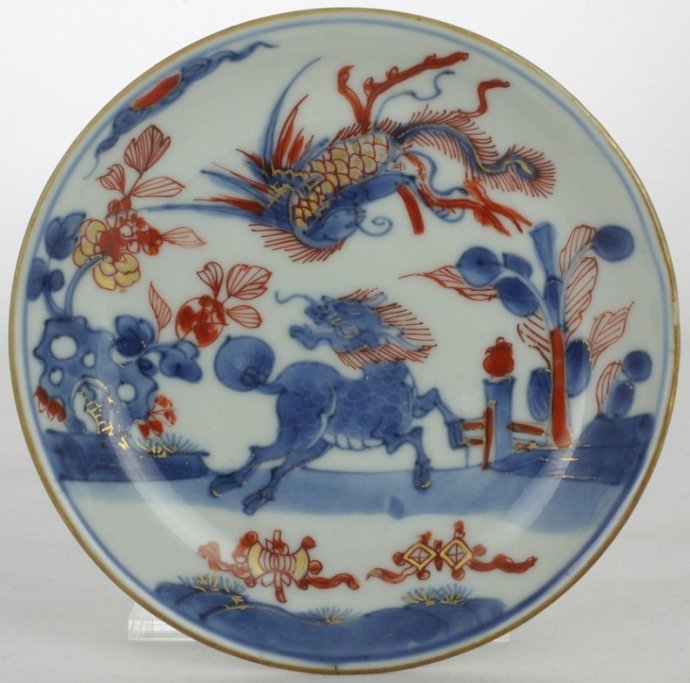
Sold Ceramics - Sold Chinese Imari 1700-1800 - Tea, Coffee and Chocolate wares - Page 2
Object 2010100K
Saucer
China
1735-1745
Height 20 mm (0.79 inch), diameter of rim 115 mm (4.53 inch), diameter of footring 65 mm (2.56 inch)
Saucer on footring, straight underglaze brown-edged rim (jia mangkou). Chinese Imari, decorated in underglaze blue, overglaze iron-red and gold with a qilin and a large phoenix flying overhead, in a garden with a balustrade, a banana tree and vegetation. On the interior wall Taoist symbols. The reverse is undecorated. The qilin, 麒麟, is a mythical animal that is composed of other animals: a sheep's head, a dragon's scales, a deer's body, the feet of a horse, the hooves and tail of an ox. It can have one horn or a pair of horns on its head. Qilins are considered good omens symbolizing prosperity, sound government, long life and fecundity. In Chinese tradition, the qilin also represents the law, wisdom, integrety and compassion. It is known throughout various East Asian cultures, and is said to appear with the imminent arrival or passing of a wise sage or an illustrious ruler. The flying feng-huang, also called feng or (misleadingly) Chinese phoenix, is in Chinese mythology, an immortal bird whose rare appearance is said to be an omen foretelling harmony at the ascent to the throne of a new emperor. Like the qilin (a unicorn-like creature), the feng-huang is often considered to signify both male and female elements, a yin-yang harmony; its name is a combination of the words feng representing the male aspect and huang the female. (Jörg 2003/2, p.57, cat 46), (Wikipedia), (Britannica Online Encyclopaedia)
The combination of two mythical animals, the kylin and the phoenix, was a popular auspicious motif. It was copied on European ceramics as typically Chinese and exotic. (Jörg 2011/2, p.46)
For similarly decorated objects, please see:
- Chinese Export Porcelain from the Museum of Antastácio Gonςalves, Lisbon, (M.A. Pinto de Matos,Pilip Wilson Publishers Limited, London / Instituto Português de Museus, Lisbon, 1996), pp.190-191, cat. 99.
- Famille Verte, Chinese Porcelain in Green Enamels, (C.J.A. Jörg, Schoten, 2011), p.46, cat. 37.
Condition: Perfect.
References:
Price: Sold.

Sold Ceramics - Sold Chinese Imari 1700-1800 - Tea, Coffee and Chocolate wares - Page 2
Object 2010729
Tea caddy
China
1730-1740
Height including cover 122 mm (4.80 inch), height excluding cover 116 mm (4.57 inch), dimensions 96 mm (3.77 inch) x 54 mm (2.13 inch), weight including cover 360 grams (12.70 ounce (oz.)), weight cover 22 grams (0.78 ounce (oz.))
Tea caddy of rectangular form with canted corners. Four flat feet at the corners. On the flat top an unglazed cylindrical mouth with its original cover. Chinese Imari, decorated in underglaze blue, overglaze iron-red and gold with on the large panels a flower head on a ruyi head flanked by leafy scrolls and on the small panels flowering plants growing from behind a garden fence. The corner panels are filled with half flower heads on an underglaze blue ground with leafy scrolls in gold. On the shoulder two flower sprays. The cover is decorated on the side with flower sprays and on top with a river scape.
Only grown in China and Japan during the 17th Century, tea became known in the Netherlands early because the Dutch East India Company (VOC) shipped small quantities home. Its use as a beverage was established slowly, and was probably started by retired VOC employees who had become accustomed to drinking tea in the East. At a tea party, the expensive beverage was served in small teapots, one for each guest, filled with the leaves of the type he or she preferred. The tea was poured into small cups, while the teapot was refilled with hot water from a metal or sometimes ceramic kettle. Teacups should be thin (Delftware cups were too thick) and porcelain was the ideal material. Fortunately, the Chinese had a long tradition of drinking tea and their cups - without handles or matching saucers - and teapots arrived in Europe in the wake of the tea cargoes. When tea became more popular, the imports of tea (and later coffee) wares increased. Matching saucers, probably based on the Islamic practice of drinking coffee from metal cups with saucers, became standard around the 1690s. Tall cups with covers were a short-lived fashion because they were too expensive, while cups with handles seem to have been introduced in the 1710s. The French started drinking tea with milk and sugar, and consequently small milk jugs made after Western models, candy pots and pattipans (small saucers placed underneath the teapot and milk jug to prevent drops from falling on the table) were introduced. Tea caddies, spoon trays and slop bpowls used to rinse the teacups followed. The tea service, with uniformly decorated components, was developed in England in the early 18th century. (Jörg 2011/2, p.131)
Condition: Various popped bubbles of glaze to rim of the cover, caused during the firing process and some glaze rough spots to the edges of the tea caddy.
References:
Exhibition: The World at Home: Asian porcelain and Delft pottery held from 17 June 2017 to 10 March 2019 at the Groninger Museum, The Netherlands.
Price: Sold.

Sold Ceramics - Sold Chinese Imari 1700-1800 - Tea, Coffee and Chocolate wares - Page 2
Object 2011203
Saucer
China
1700-1715
Height 19 mm (0.75 inch), diameter of rim 112 mm (4.41 inch), diameter of footring 61 mm (2.40 inch)
Saucer on footring, scalloped rim. Chinese Imari, decorated in underglaze blue, black, iron-red and gold with a scene from a Chinese Opera play love story named (柳 毅 傳 書), "The Dragon King's Daughter", one of the many Tang dynasty (A.D. 618-907) stories. It was widely told in China, and has been restructured in various forms in different times and regional areas. In the seventeenth century, a young scholar named Liu Yi, a scholar on his way to the capital for a civil-service examination, meets a lone shepherdess, a Dragon-Princess, who has been deserted by her husband. Liu Yi takes her letter of appeal to her father, the Dragon-King, who flies into a rage and kills her husband. Liu Yi distances himself from the rescued Princess, because he caused her widowhood. Driven by her love to Liu Yi, the Dragon-Princess transforms herself into an industrious fisherman’s daughter and she asks a matchmaker to match her with Liu Yi. On their wedding night, the obedient Liu Yi recognizes the transformed Dragon-Princess. (source: lamama.org)
The scene is well set with dangerous feel: the thick clouds covering the moon showing it as a dark night. The blue and red waves make a rough sea. The movement of the tortoise and the carp creates speed and motion. The Princess is shy but the love is so intense with her looking back and the man leaning forward while holding a flute. (I am indebted to Mr. S. Fan, Doncaster for this information)
Reference:
lamama.org, Dragon Princess PDF, 2006
Price: Sold.

Sold Ceramics - Sold Chinese Imari 1700-1800 - Tea, Coffee and Chocolate wares - Page 2
Object 2012374
Teapot
China
1710-1730
Height including the cover 98 mm (3.86 inch), diameter handle to spout 177 mm (6.97 inch), diameter of mouthrim 57 mm (2.24 inch), diameter of footring 62 mm (2.44 inch), weight with cover 349 grams (12.31 ounce (oz.)), weight cover 30 grams (1.06 ounce (oz.))
Teapot of globular shape on a footring. Straight spout with a curved C-shaped handle. The inlaying flat cover (pierced) with round knob. Chinese Imari, decorated in underglaze blue and overglaze iron-red and gold with on one side a paper folded container with a knotted ribbon filled with flowering chrysanthemum and iris branhces and on the other side a paper folded container with a knotted ribbon filled with flowering iris branches and blossoming prunus branches. Round the mouth a border with florets between scrolls in gold on an iron-red ground. On the spout and handle scattered stylised clouds motifs. On the cover two flower sprays.
Jörg states that among the Japanese motifs (taken over by the Chinese as decorating designs for Chinese Imari) were the kiku (chrysanthemum) roundels, fan-shaped panels, partly unrolled bamboo blinds and rather pronounced foliate and floral scrolls. (Jörg & Van Campen 1997, p.199) When looking closely at the chrysanthemum flower group on this teapot, one can easily spot a Japanese shaped kiku roundel (chrysanthemum flower head) between the Chinese shaped chrysanthemum flower heads and the paper folded container with knotted ribbon.
For an identically shaped, sized and decorated, Japanese Imari decorated teapot, please see:
For an example of a paper folded container, filled with flowering branches, with a knotted ribbon on a Japanese Imari bowl please see:
Condition: A firing tension hairline round the upper attachment of the handle to the teapot and a small frit to the tip of the spout.
References:
Price: Sold.

Sold Ceramics - Sold Chinese Imari 1700-1800 - Tea, Coffee and Chocolate wares - Page 2
Object 2010648
Teapot stand / pattipan
China
1730-1750
Height 27 mm (1.06 inch), dimensions rim 145 mm (5.71 inch) x 145 mm (5.71 inch), dimensions base 109 mm (4.29 inch) x 106 mm (4.17 inch), weight 244 grams (8.61 ounce (oz.))
Teapot stand / pattipan or saucer dish with spreading sides on a flat unglazed base. Used as teapot or milk jug stand. Chinese Imari, decorated in underglaze blue, overglaze iron-red and gold. The central design consists of a single flower surrounded by leaves and flowers. Around the inside rim a trellis pattern band with cartouches filled with flower heads. The exterior wall is decorated with alternating chrysanthemum and peony flower sprays.
As early as 1728 the Dutch East India Company, (Vereenigde Oost-Indische Compagnie, VOC), "Dagh-registers" state that its ship "Coxhorn" that left Amsterdam in 1728 with destination China, returned to the Netherlands on June 13th 1730, fully loaded with tea and porcelain, among its cargo were, for instance, 810 tea pots, 251 pairs of small covered sugar-boxes and 600 pattipans. A pattipan was used to protect the surface of luxurious lacquer or painted tea tables, against the influence of a hot teapot or drops running from its spout. If, in certain circles, a special tea table was not at hand it served to protect the furniture or its valuable table-cloth from tea spots. The Dutch word "pattipan" is most likely derived from the English word "patty pan" meaning a pastry mould for little pies or pastries. These "patty pans" were very similar, in shape and size, to our "pattipannen". (Volker 1959), (Kleyn 1980, pp. 253-261)
Condition: Extensively fritted round the rim and edges and wear to the trellis pattern decoration probably due to extensive use during its lifetime.
References:
Price: Sold.
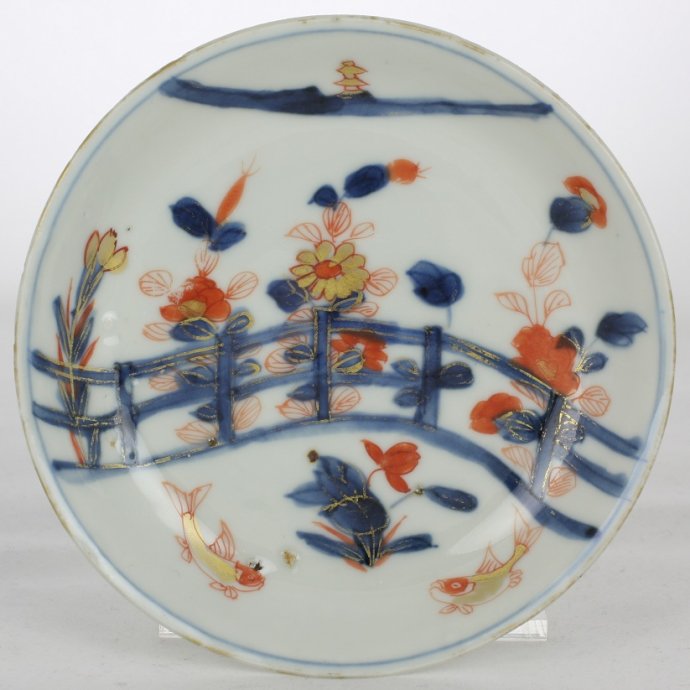
Sold Ceramics - Sold Chinese Imari 1700-1800 - Tea, Coffee and Chocolate wares - Page 2
Object 201031A
Saucer
China
1720-1740
Height 18 mm (0.71 inch), diameter of rim 114 mm (4.49 inch), diameter of footring 64 mm (2.52 inch), ), weight 63 grams (2.22 ounce (oz.))
Saucer on footring, slightly everted rim. Chinese Imari, decorated in underglaze blue, overglaze iron-red and gold with in the foreground a fenced pond with two swimming fish near a lotus bud. Behind the fence flowering chrysanthemum and peony plants and in the background mountains and a pagoda. On the reverse two flower sprays.
Condition: Some glaze frits and chips to the footring.
Price: Sold.

Sold Ceramics - Sold Chinese Imari 1700-1800 - Tea, Coffee and Chocolate wares - Page 2
Object 2012070
Teapot
China
1700-1720
Height including the cover 90 mm (3.54 inch), diameter handle to spout 105 mm (4.13 inch), diameter of mouthrim 27 mm (1.06 inch), diameter of footring 33 mm (1.30 inch), weight with cover 140 grams (4.94 ounce (oz.)), weight cover 11 grams (0.39 ounce (oz.))
Teapot on footring, the body of elongated barrel shape, a straight spout and C-shaped handle. domed flat cover with a round knob. Chinese Imari, decorated in underglaze blue, overglaze iron-red and gold on both sides with a shaped panel filled with two cockerels facing each other separated by a flowering plant growing from a taihu (garden) rock. On the handle, the spout and In between both panels, just under the spout, a single flower spray. The cover is decorated with a flower spray and a single butterfly.
The motif of cockerels was popular on ko-akae and ko-sometsuke. The cock represents yang, the masculine principle, and a pair of fighting cocks symbolises courage and martial spirt. Bottles with this design have been found in tombs dated to 1628 and 1634. (Jörg 2011/2, p.17, cat. 6 & 7)
For other objects decorated with two cockerels facing each other, please see:
For a Chinese teapot similarly decorated with two cockerels, please see:
Japanese Imari was exported to Europe from the last quarter of the 17th century by the Dutch. The Chinese began copying Imari porcelain - far more cheaply, just as adeptly and in an ever larger range of shapes - in the early 18th century. The early 18th century has left little written documentary evidence of Chinese Imari. It was often entered as Japanese in inventories such as those drawn up at Dresden, whilst in shipping lists it was not described in sufficient detail to be identified. Dutch private traders began importing enormous quantities of imari of around 1720. Their shapes were likewise often geared towards European source material in silver, stoneware or glass. (Düsseldorf 2015, pp.222-223)
Conditions:
Teapot: Some popped bubbles of glaze, caused by the firing process, and a glaze chip to the handle.
Cover: Various chips to the rim.
References:
Düsseldorf 2015, pp.222-223 & cat.126
Price: Sold.

Sold Ceramics - Sold Chinese Imari 1700-1800 - Tea, Coffee and Chocolate wares - Page 2
Object 2010100H
Saucer
China
1720-1740
Height 19 mm (0.75 inch), diameter of rim 101 mm (3.98 inch), diameter of footring 56 mm (2.20 inch), ), weight 59 grams (2.08 ounce (oz.))
Saucer on footring, slightly everted rim. Chinese Imari, decorated in underglaze blue, overglaze iron-red and gold with flowering chrysanthemum and peony plants growing from a taihu (garden) rock and flanked by butterflies in flight. In the centre two crossed (bamboo/) reeds tied together in the middle. On the reverse two flower sprays.
The striking distinctive feature of the crossed reed is probably the Chinese decorators interpretation of Japanese zig-zag plank bridges (yatsuhashi) a decorating feature often seen on Japanese Imari porcelain. In his book Fine & Curious (page 182, cat. 224a) Jörg shows an early 18th century Japanese Imari decorated saucer from the collection of Oriental ceramics from the Groninger Museum which is very similarly decorated.
Reproduced from: Fine & Curious: Japanese Export Porcelain in Dutch Collections, (C.J.A. Jörg, Hotei Publishing, Amsterdam 2003), p.182, cat. 224a. (copyright in bibliographic data and cover images is held by the publisher or by their respective licensors: all rights reserved)
Condition: Some tiny fleebites to the rim.
Price: Sold.

Sold Ceramics - Sold Chinese Imari 1700-1800 - Tea, Coffee and Chocolate wares - Page 2
Object 2010728
Milk jug
China
1710-1720
Height including the cover 135 mm (5.31 inch), diameter 92 mm (3.62 inch), diameter of mouthrim 52 mm, (2.05 inch), diameter of footring 48 mm (1.89 inch), weight with cover 270 grams (9.52 ounce (oz.)), weight cover 43 grams (1.52 ounce (oz.))
Milk jug on footring, pear shaped body with handle, small triangular spout at the rim. The C-shaped handle is placed opposite the spout. Domed cover with round knob. Chinese Imari, decorated in underglaze blue, overglaze iron-red and gold with various flowering plants. Round the mouthrim and the rim of the cover a zig-zag lines pattern border with half flower-heads. On the handle a single flowering stem. The cover has been pierced.
For an identically shaped and decorated milk jug, please see:
Condition: Two tiny fleabites to the tip of the spout and some spots of popped bubbles of glaze to the handle, caused during the firing process.
Reference:
Museum De Lakenhal, inv.nr. B 371
Price: Sold.
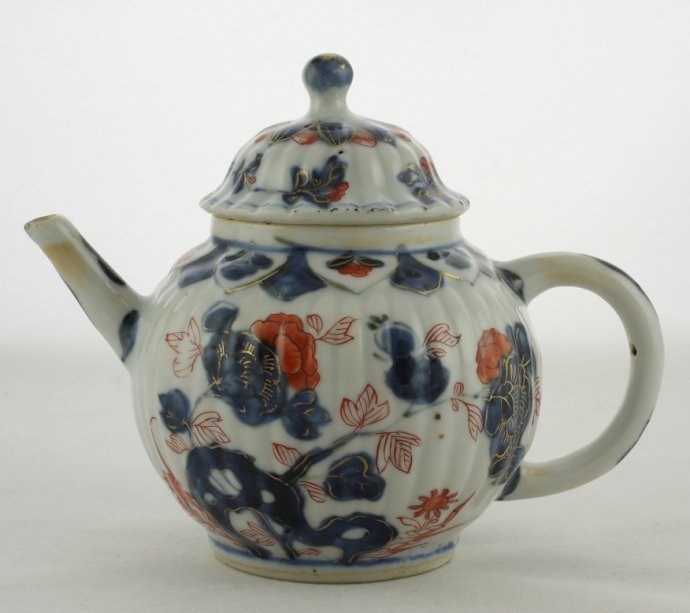
Sold Ceramics - Sold Chinese Imari 1700-1800 - Tea, Coffee and Chocolate wares - Page 2
Object 2011383
Teapot
China
1700-1720
Height 106 mm (4.17 inch), diameter ear to spout 141 mm (5.55 inch), diameter of mouthrim 51 mm (2.01 inch), diameter of footring 51 mm (2.01 inch)
Teapot on footring, ribbed body and cover, straight spout and C-shaped handle. Domed cover with round knob. Chinese Imari, decorated in underglaze blue, overglaze iron-red and gold with flowering chrysanthemum plants growing from pierced rockwork, on the reverse side flowering peony plants also growing from pierced rockwork. Around the neck and top of the cover a lotus shaped panel border in relief filled with flower heads. On the cover two flower sprays, on the handle and spout, single flowering stems.
Condition: Two tiny fleabites to the tip of the spout, a chip to the inside of the mouthrim and some very tiny spots on the rim of the cover, caused by popped bubbles of glaze during the firing process.
Price: Sold.

Sold Ceramics - Sold Chinese Imari 1700-1800 - Tea, Coffee and Chocolate wares - Page 2
Object 2011169
Tea caddy
China
1720-1730
Height including cover 127 mm (5.00 inch), height excluding cover 106 mm (4.17 inch), dimensions 60 mm (2.36 inch) x 60 mm (2.36 inch), diameter of mouthrim 24 mm (0.94 inch), weight including cover 250 grams (8.82 ounce (oz.)), weight cover 11 grams (0.39 ounce (oz.))
Tea caddy of square form with canted corners. Four flat feet at the corners. A flat shoulder and a short upright neck. Chinese Imari, decorated in underglaze blue, iron-red and gold. The original cover is missing. Fitted with silver mounts (unmarked). Decorated with different flowering plants like; peony, aster, banana and cherry growing from pierced rockwork and a table with flower baskets filled with various flowering plants. On the flat shoulder four cartouches filled with flowering plants on a trellis pattern ground with four single flower heads.
Many flowering plants all have their own symbolism; depicted together they also symbolise nature's wealth, and hence riches. (Jörg 2011/2, p.36)
Condition: Some glaze rough spots to the edges.
References:
Price: Sold.

Sold Ceramics - Sold Chinese Imari 1700-1800 - Tea, Coffee and Chocolate wares - Page 2
Object 2011753
Tea caddy
China
1730-1740
Height including cover 145 mm (5.71 inch), height excluding cover 110 mm (4.33 inch), dimensions 93 mm (3.66 inch) x 51 mm (2.01 inch), weight including cover 297 grams (10.48 ounce (oz.)), weight cover 8 grams (0.28 ounce (oz.))
Tea caddy of rectangular form with canted corners. Four flat feet at the corners. On the flat top an unglazed cylindrical mouth. The original cover is missing. Fitted with marked Dutch silver mounts. Chinese Imari, decorated in underglaze blue, overglaze iron-red and gold with flowerheads and flower sprays on each facet of the body and shoulder. The silver marks explained: the makers mark '2F' it is not known to me to whom this mark refers, the sword mark was used (1814-1905) as the standard mark on articles too small for the full hallmarking.
Condition: Various popped bubbles of glaze to the edges caused during the firing process and some glaze rough spots to the edges. A shallow glaze chip to the shoulder.
Price: Sold.
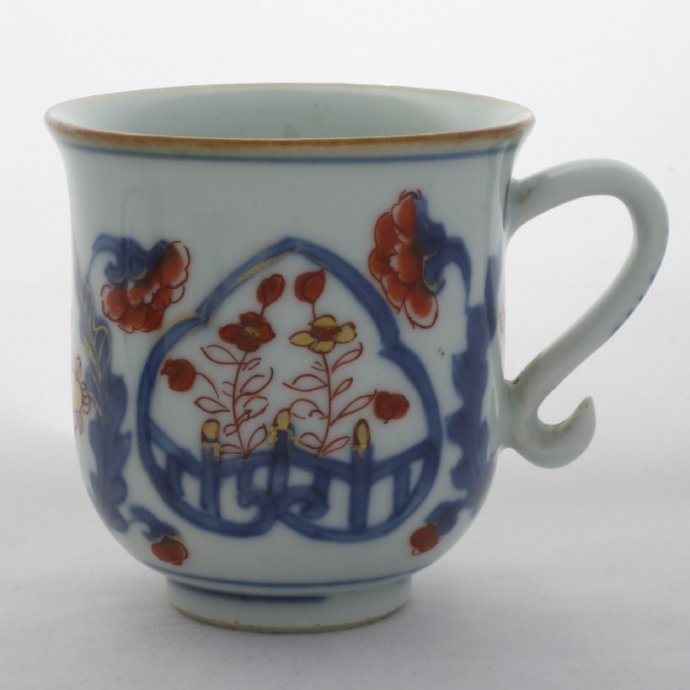
Sold Ceramics - Sold Chinese Imari 1700-1800 - Tea, Coffee and Chocolate wares - Page 2
Object 2010235
Coffee cup
China
1720-1750
Height 73 mm (3.50 inch), diameter of rim 70 mm (2.36 inch), diameter of footring 34 mm (1.38 inch)
Coffee cup with handle on footring with an underglaze brown-edged rim (jia mangkou). Chinese Imari decorated in underglaze blue, iron-red and gold. On the cylindrical wall two medallions filled with flowering plants behind a fence, in between the medallions branches of flowering plants.
Condition: A chip to the rim and a frit to the inner footring
References:
Price: Sold.

Sold Ceramics - Sold Chinese Imari 1700-1800 - Tea, Coffee and Chocolate wares - Page 2
Object 2011040
Tea caddy
China
1720-1730
Height with silver mounts 147 mm (5.78 inch), height base to shoulder 85 mm (3.35 inch), dimensions 53 mm (2.09 inch) x 91 mm (3.58 inch)
Tea caddy of rectangular form with canted corners and flat shoulder with a short upright neck. The edge in underglaze light brown (jia mangkou). Unglazed base. The original cover is missing and replaced with unmarked Dutch silver mounts. Chinese Imari decorated in underglaze blue and overglaze iron-red and gold with on the sides and top with a continuous riverscape with pagodas, trees, mountains and clouds. The silver marks explained: the marker’s mark: J3, the sword mark was used (1814-1905) as the standard mark on articles too small for the full hallmarking.
Condition: Some very tiny glaze frits to the edges.
Reference:
Price: Sold.

Sold Ceramics - Sold Chinese Imari 1700-1800 - Tea, Coffee and Chocolate wares - Page 2
Object 2012029
Teapot
China
1710-1730
Height with cover 127 mm (5.00 inch), height without cover 92 mm (3.62 inch), diameter handle to spout 182 mm (7.17 inch), diameter of mouthrim 58 mm (2.28 inch), diameter of footring 55 mm (2.17 inch), weight with cover 485 grams (17.11 ounce (oz.)), weight cover 87 grams (3.07 ounce (oz.))
A ribbed teapot and cover of globular shape on footring. Straight spout with a curved C-shaped handle. Domed cover with a pointed knob. On the spout fitted with an unmarked silver mount. The edge of the cover in underglaze brown (jia mangkou). Chinese Imari, decorated in underglaze blue, overglaze iron-red, and gold. On the body on both sides two fan-shaped reserves filled with a bird perched on a flowering prunus branch flanked by two groups of flowering plants. Under the spout and in between the handle two small round reserves filled with a single flower spray. Around the neck florets between scrolls. The cover is similarly decorated with two large reserves containing a bird perched on a flowering prunus branch and two small round reserves filled with a single flower spray. In between the panels a flower spray, On the handle and spout flower sprays.
An identical teapot can be found in the collection of the Jan Menze van Diepen Foundation at Slochteren, the Netherlands (JMD-P-0850)
For a similarly shaped and identically decorated teapot, please see:
Condition: A firing tension hairline to the handle and a restored finial.
References:
Price: Sold.

Sold Ceramics - Sold Chinese Imari 1700-1800 - Tea, Coffee and Chocolate wares - Page 2
Object 2011420
Tea caddy
China
1710-1730
Height with cover 114 mm (4.48 inch), height without cover 98 mm (3.86 inch), dimensions 90 mm (3.54 inch) x 56 mm (2.20 inch), diameter of mouthrim 25 mm (0.98 inch), weight with cover 274 grams (9.67 ounce (oz.)), weight cover 13 grams (0.46 ounce (oz.))
Tea-caddy of rectangular form with canted corners, a flat shoulder with a upright unglazed neck. The original cover is missing and replaced with a contemporary mahogany version. The flat base is unglazed. Chinese Imari, decorated in underglaze blue, overglaze iron-red, and gold. On the body and the flat shoulders decorated with various flowering plants. Round the foot, shoulder and neck a meander pattern border.
For an identically shaped and decorated tea caddy, please see:
Condition: Two chips and glaze rough spots on various edges.
Reference:
Price: Sold.

Sold Ceramics - Sold Chinese Imari 1700-1800 - Tea, Coffee and Chocolate wares - Page 2
Object 2011947
Teapot
China
1710-1720
Height including the cover 119 mm (4.69 inch), diameter handle to spout 175 mm (6.89 inch), diameter of mouthrim 43 mm (1.69 inch), diameter of footring 52 mm (2.05 inch), weight with cover 414 grams (14.60 ounce (oz.)), weight cover 39 grams (1.38 ounce (oz.))
Teapot of globular shape on footring with low rim and a flat cover with round knob. Straight spout with a curved C-shaped handle. Chinese Imari, decorated in underglaze blue, iron-red, green and black enamel and gold enclosing two panels, one with a flowering chrysanthemum growing from a brushwood fence, the other with a flowering peony growing from a brushwood fence. The panels are divided by golden scrolls and half flower heads on an underglaze blue ground. On the handle and spout florets between scrolls. The cover is decorated en suite.
This brushwood fence, made up of bundles of twigs tied together is frequently combined with a bamboo trellis, an enlarged branch of a flowering peony tree and a shishi. It is a motif that occurs frequently on Kakiemon, and one which evidently appealed greatly to the European consumer, given the fact that it is often seen on European imitations of Kakiemon. (Fitski 2011, p.148)
Japanese Imari was exported to Europe from the last quarter of the 17th century by the Dutch. The Chinese began copying Imari porcelain - far more cheaply, just as adeptly and in an ever larger range of shapes - in the early 18th century. The early 18th century has left little written documentary evidence of Chinese Imari. It was often entered as Japanese in inventories such as those drawn up at Dresden, whilst in shipping lists it was not described in sufficient detail to be identified. Dutch private traders began importing enormous quantities of imari of around 1720. Their shapes were likewise often geared towards European source material in silver, stoneware or glass. (Düsseldorf 2015, pp.222-223)
For a pair of bowls, decorated in the same style, please see:
Condition: Three firing flaws to the underside of the cover and a few very shallow rough spots to the footring.
References:
Düsseldorf 2015, pp.222-223 & cat.126
Price: Sold.
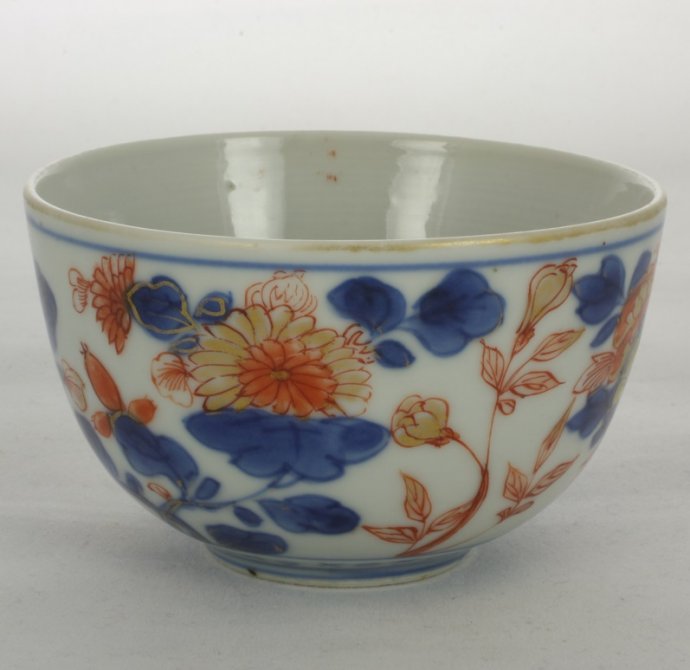
Sold Ceramics - Sold Chinese Imari 1700-1800 - Tea, Coffee and Chocolate wares - Page 2
Object 2010114
Sugar bowl
China
1720-1740
Height 49 mm (1.93 inch), diameter of rim 82 mm (3.23 inch), diameter of footring 35 mm (1.38 inch), weight 124 grams (4.37 ounce (oz.))
Small bowl on footring, straight rim. Imari, decorated in underglaze blue and overglaze iron-red and gold with flowering chrysanthemum and peony plants. Round the footing a marubatsu pattern (modern Japanese for 'naughts and crosses' or 'Os and Xs'). On the bottom a single flower head.
Condition: Perfect.
Price: Sold.
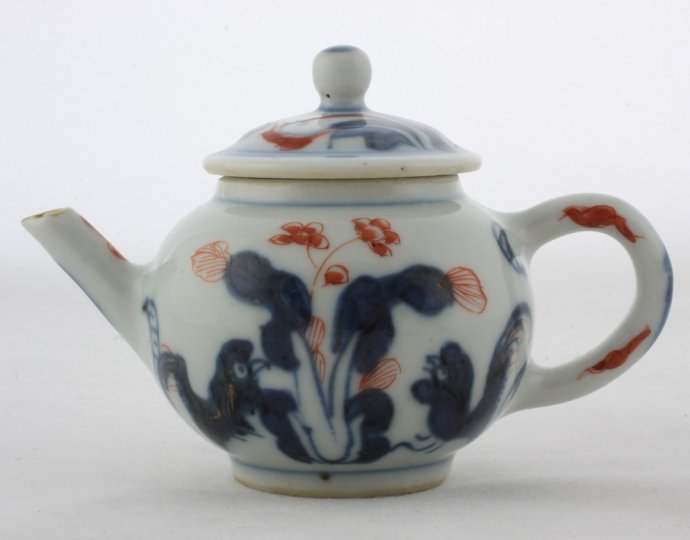
Sold Ceramics - Sold Chinese Imari 1700-1800 - Tea, Coffee and Chocolate wares - Page 2
Object 2010713
Miniature teapot
China
c.1740
Height 67 mm (2.64 inch), diameter handle to spout 102 mm (4.02 inch), diameter of mouthrim 35 mm (1.38 inch), diameter of footring 32 mm (1.26 inch)
Miniature teapot on footring, straight spout and C-shaped handle. domed low cover with a round knob. Chinese Imari, decorated in underglaze blue, overglaze iron-red and gold one side with two cockerels facing each other separated by a flowering plant growing from a taihu (garden) rock, on the other side with a single plant. On the spout and handle sprays of florets between scrolls. A banana plant covers almost the entire cover.
The motif of cockerels was popular on ko-akae and ko-sometsuke. The cock represents yang, the masculine principle, and a pair of fighting cocks symbolises courage and martial spirt. Bottles with this design have been found in tombs dated to 1628 and 1634. (Jörg 2011/2, p.17, cat. 6 & 7)
For other objects decorated with two cockerels facing each other, please see:
This teapot was most likely part of a child's tea set. These toy tea sets were indeed used by children for entertaining guests at tea parties as a common element of their socialization training. Such occasions, however, would have been held under the supervision of adults. (Pardue 2008, p.2)
Condition: A firing flaw to the footring and a frit to the inner mouthrim.
References:
Price: Sold.

Object 2010115
Tea caddy
China
1700-1720
Height with cover 105 mm (4.13 inch), dimensions 75 mm (2.95 inch) x 60 mm (2.36 inch)
Tea caddy of moulded fan-shaped form. On the flat shoulder an unglazed cylindrical mouth with a lid fitting (original) cover. The base is unglazed. Chinese Imari, decorated in underglaze blue, overglaze iron-red and gold in low relief with four moulded panels, one with a garden wall, a porch and a window, in low relief, flowering plants and a pine-tree, two with a pavilion on a shore in a river scape in low relief and one with a bridge between two pieces of land and large rockwork with flowering plants in low relief. On the flat shoulder the unglazed cylindrical mouth is flanked by flowering plants. On the side of the cover two flowering branches and on top a pavilion near a shore with mountains in the background.
Only grown in China and Japan during the 17th Century, tea became known in the Netherlands early because the Dutch East India Company (VOC) shipped small quantities home. Its use as a beverage was established slowly, and was probably started by retired VOC employees who had become accustomed to drinking tea in the East. At a tea party, the expensive beverage was served in small teapots, one for each guest, filled with the leaves of the type he or she preferred. The tea was poured into small cups, while the teapot was refilled with hot water from a metal or sometimes ceramic kettle. (Jörg 2011/2, p.131)
Judging from its shape this tea caddy was once part of a set of seven with one centre piece surrounded by six others and probably on a matching tray. These seven individual tea caddies were filled with various blends so each tea drinker could choose the type he or she preferred. Such a complete must have been regarded as luxury tea wares for the upper classes.
An identically shaped, sized and decorated set of tea caddies on a tray is in the collection of Augustus the Strong in Dresden and registered under the number P.O. (Porzellan Ostasien) 5589 a - h. For this set, please see;
For identically shaped, sized and decorated tea caddies, please see:
Condition: Some glaze fritting to two side edges.
References:
SKD Online collection, PO. 5589 a - h
Price: Sold.



 create websites
create websites